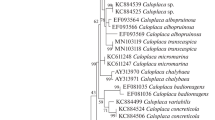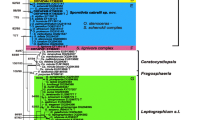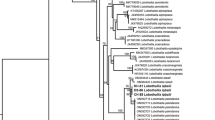Abstract
Cordyceps cuncunae Palfner sp. nov. is reported from Valdivian rainforest in southern Chile, parasiting larvae of an unidentified ghost moth species (Lepidoptera, Hepialidae) which probably feed on roots of Laureliopsis philippiana. Morphology and anatomy of stromata as well as morphological and molecular characteristics of mycelium in pure culture which produces two anamorphs, one of them Lecanicillium-like, are described. The systematic position of the new taxon within the most recent generic concept is discussed. This is the first record of an endemic Cordyceps species from Chile.





Similar content being viewed by others
References
Aung OM, Soytong K, Hyde KD (2008) Diversity of entomopathogenic fungi in rainforests of Chiang Mai Province, Thailand. Fungal Divers 30:15–22
Baldini A, Pancel L (2002) Agentes de daño en el bosque nativo. Editorial Universitaria, Santiago de Chile, p 408
Cunningham GH (1921) The genus Cordyceps in New Zealand. T Roy Soc NZ 53:372–382
Dingley JM (1953) The hypocreales of New Zealand. V. The genera Cordyceps and Torrubiella. T Roy Soc NZ 81(3):329–343
Hollermayer RPA (1937) Sobre un hongo parásito interesante de la Araucanía (Cordyceps sp.). Rev Chil Hist Nat 41:120–122
Holliday J, Cleaver M (2008) Medicinal value of the caterpillar fungi species of the genus Cordyceps (Fr.) Link (Ascomycetes). A review. Int J Med Mush 10(3):219–234
Kobayasi Y (1982) Keys to the taxa of the genera Cordyceps and Torrubiella. T Mycol Soc Jpn 23:329–364
Mains EB (1954) Species of Cordyceps on spiders. B Torrey Bot Club 81(6):492–500
Meyling NV, Eilenberg J (2007) Ecology of the entomopathogenic fungi Beauveria bassiana and Metarhizium anisopliae in temperate agroecosystems: potential for conservation biological control. Biol Control 43(2):145–155
Mueller GM, Rajchenberg M (1991) First report of Cordyceps from South American Nothofagus forests. Mycologist 5(1):46–47
Mujica F, Vergara C, Oehrens E (1980) Flora Fungosa Chilena, 2nd edn. Editorial Universitaria, Santiago, p 308
Nielsen ES, Robinson GS (1983) Ghost moths of southern South America (Lepidoptera: heplialidae). Entomograph 4:1–192
Nielsen ES, Robinson GS, Wagner DL (2000) Ghost-moths of the world: a global inventory and bibliography of the Exoporia (Mnesarchaeoidea and Hepialoidea) (Lepidoptera). J Nat Hist 34:823–878
Paterson RRM (2008) Cordyceps- a traditional Chinese medicine and another fungal therapeutic biofactory? Phytochemistry 69(7):1469–1495
Samson RA, Brady BL (1983) Paraisaria, a new genus for Isaria dubia, the anamorph of Cordyceps gracilis. Tr Br Mycol Soc 81(2):285–290
Shah PA, Pell JK (2003) Entomopathogenic fungi as biological control agents. Appl Microbiol Biot 61(5–6):413–423
Stange C, Prehn D, Arce-Johnson P (1998) Isolation of Pinus radiata genomic DNA suitable for RAPD analysis. Plant Mol Biol Report 16:1–8
Stehr FW (1987) Immature insects. Kendall-Hunt Publishing Company, Dubuque, p 754
Sung GH, Hywel-Jones NL, Sung JM, Luangsa-ard JJ, Shrestha B, Spatafora JW (2007) Phylogenetic classification of Cordyceps and the clavicipitaceous fungi. Stud Mycol 57:5–59
Sung GH, Poinar GO, Spatafora JW (2008) The oldest fossil evidence of animal parasitism by fungi supports a Cretaceous diversification of fungal-arthropod symbioses. Mol Phylogenet Evol 49:495–502
Sydow M (1932) Fungi chilensis a cl. Werdermann lecti II. Ann Mycol 30:81–90
Tao G, Liu ZY, Hyde KD, Liu XZ, Yu ZN (2008) Whole rDNA analysis reveals novel and endophytic fungi in Bletilla ochracea (Orchidaceae). Fungal Divers 33:101–122
Zare R, Gams W (2001) A revision of Verticillium section Prostrata. IV. The genera Lecanicillium and Simplicillium gen. nov. Nova Hedwigia 73(1–2):1–50
Acknowledgments
G. Palfner, J. Becerra and M. Silva acknowledge funding by CONICYT (project ADI-38), G. Palfner received additional funding by FONDECYT project 1050313. Many thanks to Dr. Angélica Casanova-Katny, Gisela Stotz, Oriet Alarcon and Flavio Espinoza for their assistance in maintenance of axenic cultures and measurements of mycelial growth.
Author information
Authors and Affiliations
Corresponding author
Rights and permissions
About this article
Cite this article
Palfner, G., Valenzuela-Muñoz, V., Gallardo-Escarate, C. et al. Cordyceps cuncunae (Ascomycota, Hypocreales), a new pleoanamorphic species from temperate rainforest in southern Chile. Mycol Progress 11, 733–739 (2012). https://doi.org/10.1007/s11557-011-0784-8
Received:
Revised:
Accepted:
Published:
Issue Date:
DOI: https://doi.org/10.1007/s11557-011-0784-8




